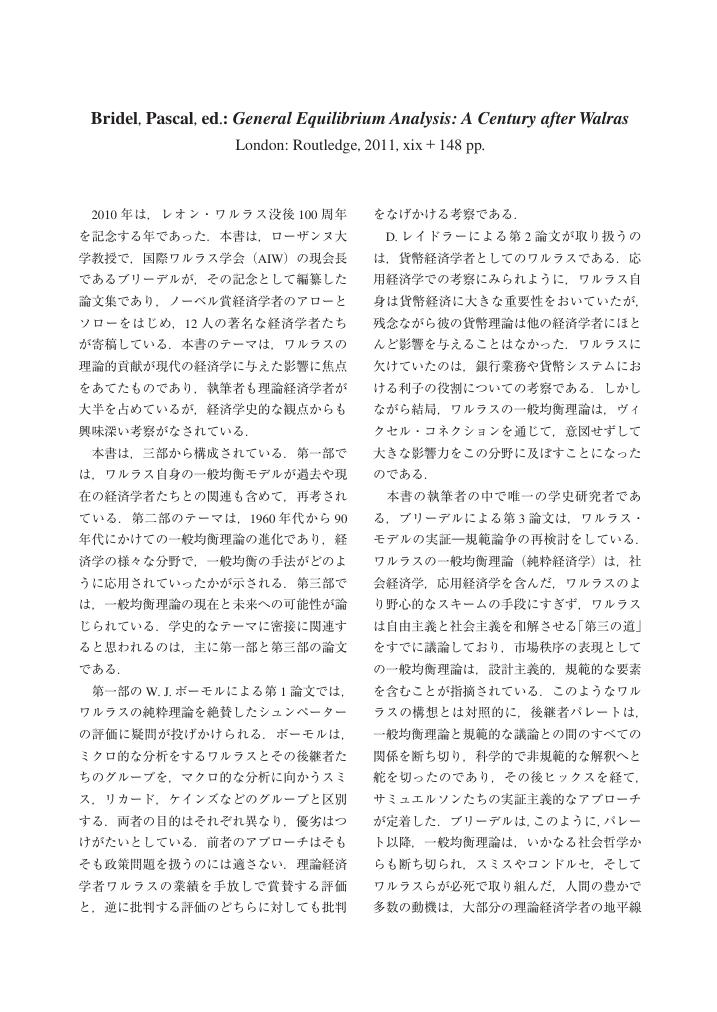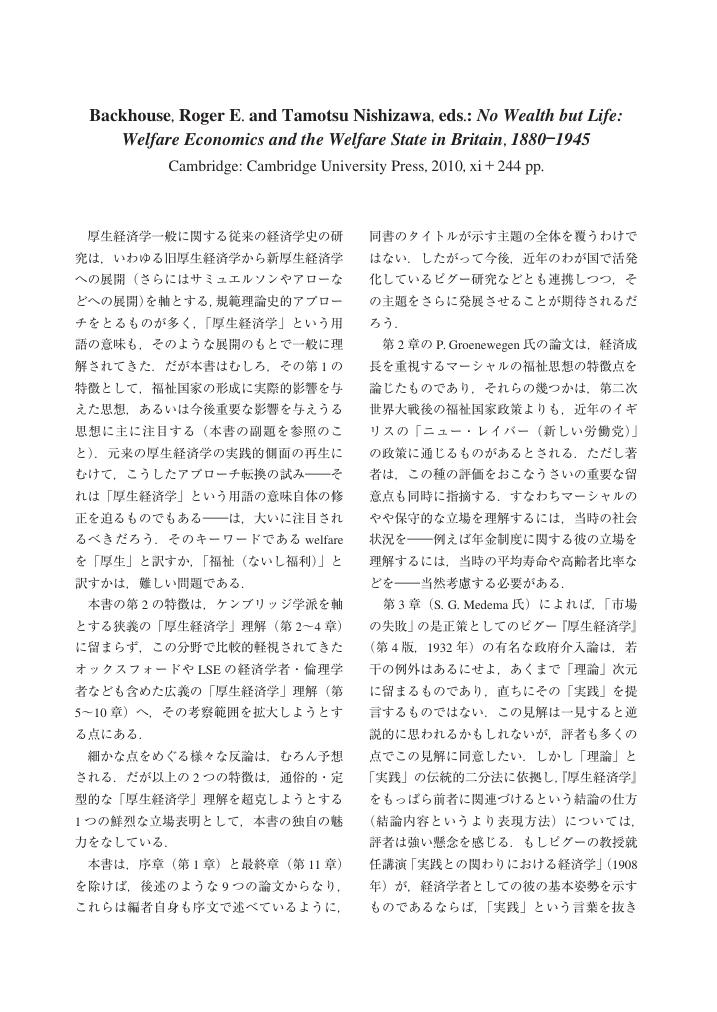- 著者
- 斉藤 悦則
- 出版者
- 経済学史学会
- 雑誌
- 経済学史研究 (ISSN:18803164)
- 巻号頁・発行日
- vol.54, no.2, pp.96-97, 2013 (Released:2019-10-31)
1 0 0 0 OA 服部正治・竹本洋編著『回想 小林昇』日本経済評論社, 2011年, iv+383頁
- 著者
- 高 哲男
- 出版者
- 経済学史学会
- 雑誌
- 経済学史研究 (ISSN:18803164)
- 巻号頁・発行日
- vol.54, no.2, pp.98-99, 2013 (Released:2019-10-31)
- 著者
- 神野 照敏
- 出版者
- 経済学史学会
- 雑誌
- 経済学史研究 (ISSN:18803164)
- 巻号頁・発行日
- vol.54, no.2, pp.100-101, 2013 (Released:2019-10-31)
- 著者
- 上條 勇
- 出版者
- 経済学史学会
- 雑誌
- 経済学史研究 (ISSN:18803164)
- 巻号頁・発行日
- vol.54, no.2, pp.102-103, 2013 (Released:2019-10-31)
1 0 0 0 OA ホブスン帝国主義論における社会進化論的思考
- 著者
- 尾崎 邦博
- 出版者
- 経済学史学会
- 雑誌
- 経済学史研究 (ISSN:18803164)
- 巻号頁・発行日
- vol.54, no.2, pp.29-44, 2013 (Released:2019-08-22)
John Atkinson Hobson, the leading theorist of the New Liberalism, is known as a sharp critic of imperialism. As is well known, the formative period of his social and political thought coin-cided with the heyday of social evolution theory. The purpose of this paper is to ascertain to what extent his theory of imperialism was under the influence of that theory. In his search for a remedy for the diseases of modern industrial societies, which were under the dominion of machine production and the law of diminishing returns, he proposed to substitute qualitative for quantitative methods of consump-tion. Thus, he adopted a qualitative view of social progress, insisting that by improving the charac-ter of consumption, the law of diminishing re-turns could be defeated, whereas the biological defenders of imperialism, such as Benjamin Kidd and Karl Pearson, maintained a quantitative view of progress, assuming that social effi-ciency and racial success were to be measured in square miles of territory within the empire. While claiming that the struggle for exist-ence within a society should be suspended for such a society to be able to compete successfully with another society, Pearson argued that the primitive struggle for physical existence was the best method for securing progress for the society of nations, which could be called humanity. In refuting Pearsonʼs view of progress, Hob-son asked why such a view, which claimed to put down the struggle for life among individuals and enlarge the area of social internal peace un-til it covered a whole nation, should not claim to extend its mode of progress to the complete so-ciety of the human race. JEL classification numbers: B 14, B 15.
1 0 0 0 OA L. T. ホブハウスにおけるニューリベラリズムの社会改革思想 中間団体論と分配論の連関
- 著者
- 寺尾 範野
- 出版者
- 経済学史学会
- 雑誌
- 経済学史研究 (ISSN:18803164)
- 巻号頁・発行日
- vol.54, no.2, pp.45-61, 2013 (Released:2019-08-22)
- 被引用文献数
- 1 1
This paper examines British new liberal thinker L.T. Hobhouseʼs (1864―1929) views on social reform with a particular focus on the connection between his early economic thought on volun-tary organizations and his later ethical theory of distributive justice, and demonstrates that these aspects of his thought were theoretically com-plementary, together composing Hobhouseʼs life-long pursuit of the moralization of capital-ism. In the 1890s, Hobhouse already shared with contemporaneous new liberals several moralistic concerns over the issue of social reform. They all (1) thought of the development of morality as the fundamental aim of social reform and (2) emphasized the stateʼs duty to provide individu-als with the legal conditions necessary for moral development. Early in his career, Hobhouse fo-cused on the first point, identifying trade unions and co-operative societies as effective agencies for instilling in workers the values of fellowship and mutual aid. Hobhouse developed his ideas on state inter-ference after the 1910s, particularly from the perspective of distributive justice. Individuals were considered to have reciprocal rights and duties in relation to others and the state: they were seen as having the right to demand legal, material and social conditions sufficient for de-veloping their moral personalities and the duty to undertake their own social functions. A just distribution ensured by the state was seen as be-ing one that was capable of maintaining the per-formance of such functions. Hobhouse saw the roles of intermediate or-ganizations and the state as complementary, thus developing new liberal thought on social reform from a pluralistic-cum-moralistic perspective. To what extent this “ethical welfare pluralism” was common at the turn of the century would be a question worth examining in the historical study of the British welfare state. JEL classification numbers: B 19, B 31, I 31.
- 著者
- 石井 信之
- 出版者
- 経済学史学会
- 雑誌
- 経済学史研究 (ISSN:18803164)
- 巻号頁・発行日
- vol.54, no.2, pp.77-78, 2013 (Released:2019-10-31)
- 著者
- 御崎 加代子
- 出版者
- 経済学史学会
- 雑誌
- 経済学史研究 (ISSN:18803164)
- 巻号頁・発行日
- vol.54, no.2, pp.79-80, 2013 (Released:2019-10-31)
- 著者
- 木村 雄一
- 出版者
- 経済学史学会
- 雑誌
- 経済学史研究 (ISSN:18803164)
- 巻号頁・発行日
- vol.54, no.2, pp.81-82, 2013 (Released:2019-10-31)
- 著者
- 若森 みどり
- 出版者
- 経済学史学会
- 雑誌
- 経済学史研究 (ISSN:18803164)
- 巻号頁・発行日
- vol.54, no.2, pp.83-85, 2013 (Released:2019-10-31)
- 著者
- 池田 幸弘
- 出版者
- 経済学史学会
- 雑誌
- 経済学史研究 (ISSN:18803164)
- 巻号頁・発行日
- vol.54, no.1, pp.122-123, 2012 (Released:2019-10-31)
- 著者
- 古谷 豊
- 出版者
- 経済学史学会
- 雑誌
- 経済学史研究 (ISSN:18803164)
- 巻号頁・発行日
- vol.54, no.1, pp.124-125, 2012 (Released:2019-10-31)
- 著者
- 保住 敏彦
- 出版者
- 経済学史学会
- 雑誌
- 経済学史研究 (ISSN:18803164)
- 巻号頁・発行日
- vol.54, no.1, pp.126-127, 2012 (Released:2019-10-31)
1 0 0 0 OA 楠茂樹『ハイエク主義の「企業の社会的責任」論』勁草書房, 2010年, v+202頁
- 著者
- 吉野 裕介
- 出版者
- 経済学史学会
- 雑誌
- 経済学史研究 (ISSN:18803164)
- 巻号頁・発行日
- vol.54, no.1, pp.128-129, 2012 (Released:2019-10-31)
- 参考文献数
- 2
- 著者
- 藤田 菜々子
- 出版者
- 経済学史学会
- 雑誌
- 経済学史研究 (ISSN:18803164)
- 巻号頁・発行日
- vol.54, no.1, pp.130-131, 2012 (Released:2019-10-31)
1 0 0 0 OA ルーカスの始原から マクロ合理的期待モデルの誕生と屈折するシカゴ
- 著者
- 山崎 好裕
- 出版者
- 経済学史学会
- 雑誌
- 経済学史研究 (ISSN:18803164)
- 巻号頁・発行日
- vol.54, no.2, pp.11-29, 2012 (Released:2019-08-22)
This paper focuses on three papers by Lucas in his early career as a macroeconomist. Consider-ing Lucas and Rapping (1969), Lucas and Pres-cott (1970), and Lucas (1972) successively, we found that Lucasʼs first macro rational expecta-tion model was built combining his macroeco-nomic interest in labor supply and smart mathe-matical techniques to treat a stochastic process and probability. The former had arisen through research from a Keynesian perspective. The latter was the result of research on the investment function, which was parallel to Tobinʼs q theory. We can therefore conclude that Lucasʼs econom-ics was born in a more Keynesian context than has ever been thought. This historical aspect has been virtually neglected by those who thought much of ideological slogans of the macro ration-al expectation school. Lucas (1972), which pro-vided the first macro rational expectation model, was too complicated in terms of structure. Be-sides its very structure, however, it is more important to point out that Lucas introduced to modern macroeconomic theory the concept that stochastic shocks are the main causal factors of economic fluctuations. This revived the lost leg-acy in the early history of econometric research. Lucasʼs economics turns out to have a very interesting feature from this point of view. Though it always retains general equilibrium as the reference axis, it tends to escape from the equilibrium strongly determined by the excess power of the economy. When Lucas built an endogenous growth model, he added an external effect term to Uzawaʼs production function. Such a com-pound feature of Lucasʼs economics made the Chicago school more comprehensive and truly the mainstream of contemporary macroeconom-ics. JEL classification numbers: B 22, E 13.
1 0 0 0 OA カンティロンの「利潤」概念 スミス以後の貧困問題を中心に
- 著者
- 金子 創
- 出版者
- 経済学史学会
- 雑誌
- 経済学史研究 (ISSN:18803164)
- 巻号頁・発行日
- vol.54, no.1, pp.82-99, 2012 (Released:2019-08-22)
The purpose of this article is to reinterpret Rich-ard Cantillonʼs concept of “profit” described in his Essai sur la nature du commerce en général (1755). It examines the conceptual relation between profit and Cantillonʼs two notions “intrin-sic value” and “entrepreneur.” By examining Prendergastʼs (1991) two possible interpretations of the relation of profit with the intrinsic value of a commodity and Brewerʼs (1992) discussion of entrepreneursʼ credit-worthiness, it is shown that Cantillonʼs profit interpreted by Prendergast is constructed of certain and uncertain parts. Certain part of the profit accruing to a commodity producer is the difference between the producerʼs labor value and subsistence level, and uncertain part, which characterizes the producer as an entrepreneur, is the balance between the sales price and the in-trinsic value of a commodity. This construction enables us to interpret Cantillonʼs profit with reference to entrepre-neursʼ labor value and to provide restrictive defi-nitions of Cantillonʼs notions of intrinsic value and entrepreneur. These restrictive definitions, which take into consideration the idea of long-run equilibrium price, indicate that Cantillonʼs notions of intrin-sic value and entrepreneur differ from Adam Smithʼs versions of “natural price” and “employ-er,” respectively. It is shown that the state where-in the price of each commodity equalizes with its intrinsic value and the existence of an entre-preneur receiving uncertain profit are conceptu-ally incompatible in economies in Cantillonʼs ar-gument. Our interpretations represent an explanation for the conceptual change of profit from Cantil-lon to Smith. JEL classification numbers: B11, B31.
1 0 0 0 OA 新村聡氏の書評に答える
- 著者
- 星野 彰男
- 出版者
- 経済学史学会
- 雑誌
- 経済学史研究 (ISSN:18803164)
- 巻号頁・発行日
- vol.54, no.1, pp.106-107, 2012 (Released:2019-08-22)
- 著者
- 本郷 亮
- 出版者
- 経済学史学会
- 雑誌
- 経済学史研究 (ISSN:18803164)
- 巻号頁・発行日
- vol.54, no.1, pp.112-113, 2012 (Released:2019-10-31)
- 著者
- 松井 名津
- 出版者
- 経済学史学会
- 雑誌
- 経済学史研究 (ISSN:18803164)
- 巻号頁・発行日
- vol.54, no.1, pp.114-115, 2012 (Released:2019-10-31)















